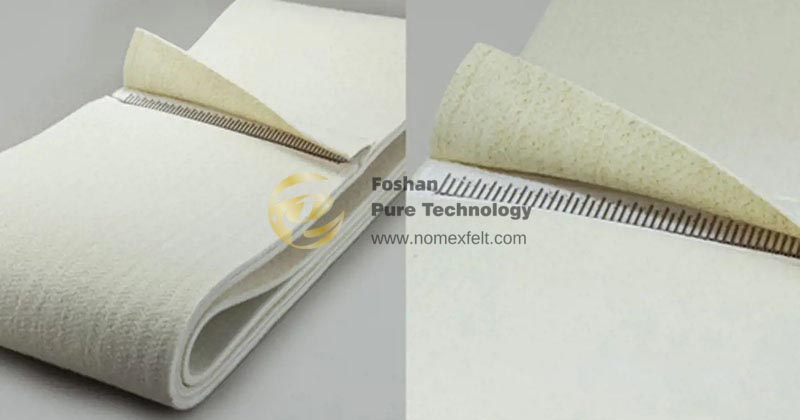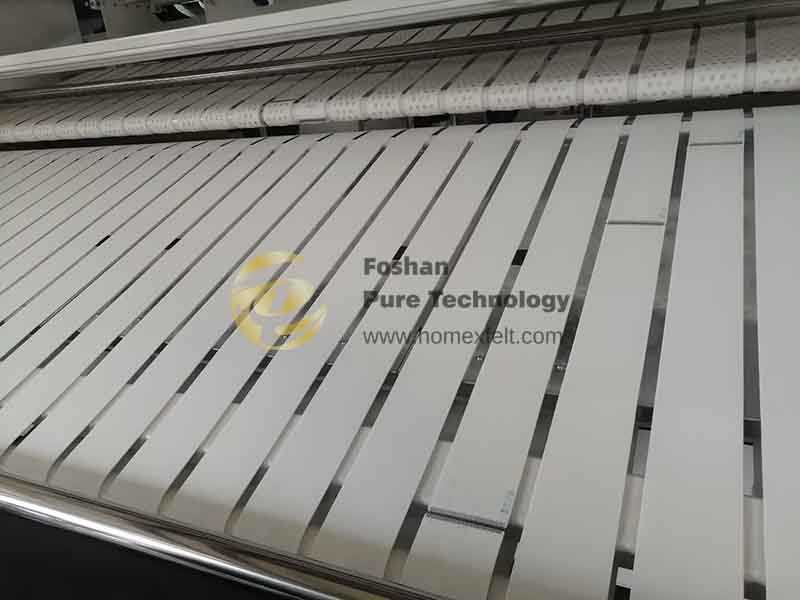Do you often worry about the efficiency and quality of the clothes ironing machine?
Do you want a flat and stable laundry belt under high temperatures?
Do you still not know how to adjust the laundry belt?
These questions are undoubtedly what laundry practitioners all want to know.
As an important piece of equipment in industries such as textile and garment processing The operating condition of the ironing belt of an industrial ironing machine is related to the smoothness of the production process and the quality of products.
A good laundry belt can not only work stably in a high-temperature environment but also reduce equipment failures through its stable performance
Thus, this extends the service life of the ironing machine and saves enterprises a lot of maintenance costs.

During operation, the ironing machine’s conveyor belt gradually deviates from its original normal central axis and shifts to the left or right.
One situation is a relatively slight and slow deviation, which will cause the clothes on the conveyor belt to shift along with the slight offset of the conveyor belt.
As a result, it will be difficult to keep the ironing heat and pressure received by the clothes uniform, thus affecting the uniformity of ironing.
Another situation is a more serious deviation. The clothes may get stuck at the edge of the equipment, which will prevent the normal ironing work from proceeding smoothly and the clothes may also be damaged during the jamming process.
Cause Analysis:
Installation Deviation of the Roller: If the axes at both ends of the roller are not parallel during the installation process
The ironing belt will be subjected to uneven forces when passing through this roller, thus generating a lateral component force that prompts the laundry belt to deviate to one side.
Uneven tension of the ironing belt: If the tension is not adjusted to an appropriate and uniform state during the installation, commissioning, or daily use, it will lead to the problem of deviation.
Uneven distribution of materials: If the ironed items are not placed evenly on the ironing belt or if there is too large a difference in weight distribution
The ironing belt will bear uneven loads during its operation. This uneven load will lead to uneven forces on the ironing belt and then cause the phenomenon of deviation.
Slipping occurs between the laundry belt and the driving roller. When the ironing machine belt rotates on the roller
There will be brief pauses or idling instead of smoothly conveying clothes forward. Clothes cannot move on the ironing belt at the normal speed.
Cause Analysis:
Wear due to long-term use: During the long-term operation, the ironing belt and the roller are constantly rubbing against each other.
As the number of frictions increases, the material of the laundry belt will gradually wear out, resulting in a relatively longer length of the laundry belt and thus the occurrence of the looseness problem.
Improper tension setting: During the installation or commissioning stage of industrial ironing machines, if the tension of the laundry belt is not set correctly, it can easily lead to subsequent looseness problems of the laundry belt.
If the tension is set too low, the ironing belt will be in a relatively slack state from the very beginning. As time passes and with some slight stretching, the flatwork ironing belt will become looser and looser.
The amplitude must not be too large, because once it is over-adjusted, it is very likely that the ironing machine belt will deviate towards the other side instead.
Adjust the distribution of materials to assist in centering:
During the ironing process, if the distribution is not even enough, it may also cause the laundry belt to deviate.
We can adopt the method of adjusting the placement position of materials to help the laundry belt return to the central position.
When you find that the laundry belt of the ironing machine is off track due to uneven distribution of clothes
You can solve the problem by evenly distributing the clothes piled on one side to the other side, or by re-adjusting the position of the clothes.
This will help to keep the force on both sides of the conveyor belt balanced so that the conveyor belt returns to the correct center position and continues to run smoothly.
Long-term friction: During the operation of the ironing machine, the ironing belt continuously comes into contact with components such as the motor pulley and the drum and generates friction.
If the machine has a heavy load or is used intensively for a long time, the rubber material on the surface of the laundry belt will gradually wear out.
Improper installation of components: If the installation positions of the motor pulley or the drum are not accurate and there is a deviation in the fit with the laundry belt
It will cause excessive local stress on the ironing belt, thus accelerating wear.
Foreign object interference: In the working environment, if small particulate foreign objects get between the ironing belt and the transmission components
They will continuously rub against the surface of the belt, resulting in wear.
The following are common adjustment methods for the laundry industrial belt to help you improve your ironing efficiency.

Operation steps for the screw tensioning device:
Firstly, locate the screw tensioning device. If you notice signs of the Polyester ironer belt becoming loose, you can use a wrench to rotate the tensioning bolt to increase the tension.
During the adjustment process, pay attention to observing the changes in the flatwork ironer belt.
You can use a tension meter to measure the tension at different parts of the laundry ironing belt to ensure that the tension is uniform.
The ironing belt tension should be controlled within an appropriate range to avoid excessive wear of the belt caused by overly high tension or slipping due to overly low tension.
Operation steps for the weighted tensioning device:
Firstly, determine whether the laundry belt needs to increase or decrease the tension.
If it is necessary to increase the tension and the laundry belt runs to the left (deviates to the left), the weighted block can be moved appropriately to the right.
The moving distance should be adjusted according to the actual situation.
After the movement, check the running status of the laundry belt and observe whether there are still phenomena such as looseness or deviation.
Operation steps for the hydraulic tensioning device:
For the ironing machine equipped with a hydraulic tensioning device, if it is found that the ironer belt tension is insufficient, increase the hydraulic pressure on the control console.
During the adjustment process, pay close attention to the pressure display meter and adjust the pressure to an appropriate value.
Operation steps for parallel adjustment of small ironing machines:
Firstly, shut down the machine and cut off the power supply. Then, use tools to loosen the fixing bolts of the roller-bearing seat.
If the ironing belt runs to the right (deviates to the right), the operator needs to stand at the front end of the laundry belt’s running direction and carefully check.
Rotate the adjusting bolt at the front end of the right roller in the counterclockwise direction to make the front end of the roller move to the left.
The adjustment amplitude should not be too large each time, and approximately a quarter of a turn is the most appropriate.
After the adjustment is completed, tighten the fixing bolts, restart the equipment, and observe the running condition of the flatwork ironing machine belt.
If the ironing belt still fails to return to normal operation and there is still a deviation phenomenon, then the above steps can be repeated until the laundry belt can run smoothly.
Operation steps for parallel adjustment of large ironing machines:
When operating the roller adjustment system of a large ironing machine, it is necessary to strictly follow the operation manual of the equipment.
Firstly, turn on the control system interface of the equipment and find the specific option for roller adjustment.
If the ironing belt runs to the left (deviates to the left), input the corresponding instructions in the control system.
For example, in a double-roller system, to correct the deviation, the right roller should be moved either outward (gradually moving away from the central axis of the laundry belt) or upward according to the preset adjustment mode.
After completing this series of adjustment operations, the equipment can be started, and the running state of the ironing belt should be carefully observed to see if it has returned to normal.
If the ironing machine belt still fails to return to normal operation, repeat the above adjustment process until the laundry belt can run smoothly and accurately.
Adjust by using the guiding device:
Some ironing machines are equipped with belt-guiding devices, such as guide rollers or guide baffles.
If the laundry belt deviates during operation, the running track of the laundry belt can be corrected by adjusting the position of the guiding device.
If the ironing belt runs to the right, the guide roller or guide baffle on the right side can be adjusted moderately towards the center of the belt.
Then the ironing belt will be subject to a force towards the center during operation and can gradually return to the normal central position.
However, when making adjustments, it is necessary to pay attention to controlling the amplitude properly.

The above summary of common problem analysis and adjustment methods can help you solve or prevent related failures to a certain extent.
If you encounter more complicated problems during the actual operation process or still have many questions about the maintenance and adjustment of the laundry belt.
Our professional technical team is always at your service.
Whether you are seeking technical support or discussing more optimized solutions, just contact us and we will serve you.
As we know, Heat Transfer Printing Felt is suitable for fabrics, decorative fabrics, curtains, le...
Read Safety Rules for Laundry Management to be a qualified manager. PARTⅠ Laundry room Safety Gen...
The extrusion machine is the leading equipment for the production of aluminum profiles. The quali...
Heat transfer printing is a contemporary printing process in the clothing market. It prints the p...
In the textile industry, felt is only a small part but important. About how to choose felt that i...
Foshan Pure Technology Company., Ltd. helps conveyor belt manufacturers source equipment to metal...
Nomex, an intermediate aramid, also known as aramid 1313. It is characterized by good heat resist...
In the 1960s, the Dupont developed a kind of aramid composite material, it is Kevlar. It has very...